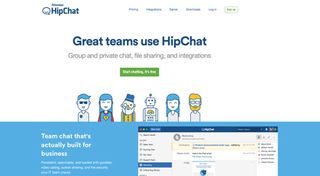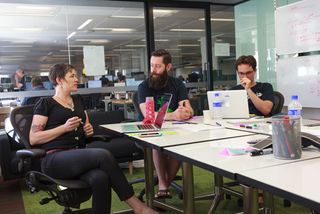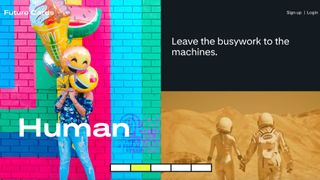6 tips for nailing your remote working culture
Collaborating across different timezones and multiple locations? Supercharge your team's efficiency with these pro tips.
Alastair Simpson is head of design for leading team collaboration platform Confluence, at Sydney-based company Atlassian. He works with design and engineering teams across different timezones – and has picked up some expert tips for highly productive remote working along the way…
'Remote working' has become one of the most notable characteristics of the 21st century. Globalisation and technology have combined to produce a culture that means your colleague may not only originate from the other side of the world, but permanently reside on the other side of the world.
As the head of design for Confluence, Atlassian's team collaboration platform, I work with a distributed design and engineering team across two locations in different timezones that have minimal crossover.
Ensuring the quality of design feedback remains high can be a real challenge. But fostering a healthy design process and culture across locations and remote workers can be done.
So what are some of the most crucial factors to ensuring you and your design team's remote working efforts are high in productivity and success? Here are six top tips…
01. Decide on your primary communication tools (and make sure it isn't email)

'Inbox hell' is the blight of an entire working generation. But relying on email to give great design feedback is a huge 'no'. It simply isn't built for this task.
There are plenty of free or affordable software tools available now that not only cut down on email hassle, but are specifically designed for remote and distributed working.
Team chat apps like HipChat are designed to help teams collaborate and include everything from instant messaging, @mentions, to video calling and screen sharing.
For quick and informal feedback we use HipChat to share early designs with our remote teams. We even have a HipChat room solely dedicated to sharing screenshots of what we are working on, with no commentary allowed. This helps ensure that members in other locations know what the rest of the team is working on.
02. Plan ahead so everyone is prepared

Careful planning is key in any design project, but with distributed teams it takes on even more importance. A few days before you run a feedback session (we call it design sparring), hold a group meeting that brings together the different teams that will be involved.
This helps give everyone involved in the feedback session an overview of the designs and context around them.
Set clear expectations of what the meeting is about. Are the designs at an early envisioning stage or production ready? Have you explained the intended user journey or the user persona being targeted?
Fully informing everyone in advance of the session maximises meeting efficiency and helps ensure you get meaningful feedback on your designs.
03. Make the most of video conferencing

We work in a visual field, so it's vital to prioritise video and live feeds over phone calls or text-based communication for group work. We use video conferencing and have a live feed displaying the items we are discussing so everyone can stay in sync during the meeting.
This is much more efficient than relying on each team member to open the correct files themselves on their own device as the meeting progresses.
Selecting a lead who will drive the meeting, walk through the designs and keep the feedback focused helps keep the team on track and prevents the meeting from running long.
Designating another team member to be responsible for keeping a record of all feedback in real time prevents items being missed or everyone having to scramble through their notes to confirm a decision or action. Every piece of design feedback is then explored and followed up after the meeting.
04. Make one person responsible for your feedback mechanism
There are many tools available now that facilitate great ways to give design feedback. For more formal feedback when working across regions, we prefer Confluence because it allows us to add comments to images.
We also use InVision app, which gives us the ability to create prototypes and add feedback to specific screens and interactions. Bounce app from Zurb is another great tool that allows feedback to be pinned to specific areas of a visual design.
Whatever you decide to use, it helps to designate one person who is responsible for managing your feedback mechanism. This keeps consistency across the project and prevents conflicts and confusion that may occur if different teams or individuals are using their own methods or set of tools.
05. If in doubt, over-communicate

Ineffective communication is the bane of any design project, but the potential for problems becomes greater when people work remotely.
When a decision is made, however small, it's vital that everyone is notified and it's clearly visible. Good communication discipline is critical, so when in doubt, it's better to play it safe and over communicate.
Similarly, it's important to make sure that the reasoning behind a decision is visible to all. A perfectly logical decision made in a team meeting may seem bizarre to someone half a world away who doesn't have context, so give background.
06. Find your team's 'golden hour'

At Atlassian, we refer to the time when local and remote teams are in their offices at the same time as the 'golden hour'. Establishing times when everyone is working at the same time, even if it's only an overlap of an hour, helps keep distributed teams feeling connected and gives them a vital opportunity to connect in real time.
This is a perfect time to schedule design stand-ups or impromptu feedback sessions with co-workers.
Fostering a healthy design process and culture in multiple locations can be hard, but it can be done. The rewards you will reap from getting your remote working structures right more than make it worth the time investment.
Words: Alastair Simpson
Tell us your remote working tips in the comments below…
Liked this? Try these...
- 10 tips for the work-at-home ninja
- How to win your dream clients
- The designer's guide to working from home

Thank you for reading 5 articles this month* Join now for unlimited access
Enjoy your first month for just £1 / $1 / €1
*Read 5 free articles per month without a subscription

Join now for unlimited access
Try first month for just £1 / $1 / €1
Get the Creative Bloq Newsletter
Daily design news, reviews, how-tos and more, as picked by the editors.
The Creative Bloq team is made up of a group of design fans, and has changed and evolved since Creative Bloq began back in 2012. The current website team consists of eight full-time members of staff: Editor Georgia Coggan, Deputy Editor Rosie Hilder, Ecommerce Editor Beren Neale, Senior News Editor Daniel Piper, Editor, Digital Art and 3D Ian Dean, Tech Reviews Editor Erlingur Einarsson and Ecommerce Writer Beth Nicholls and Staff Writer Natalie Fear, as well as a roster of freelancers from around the world. The 3D World and ImagineFX magazine teams also pitch in, ensuring that content from 3D World and ImagineFX is represented on Creative Bloq.




